Master Gardener Extension Volunteers highlighted some common invasive species found in Fayette County for National Invasive Species Awareness Week (2/24-2/28/2025) on our Facebook page. Each day, an invasive plant was highlighted to increase knowledge on identification and some native alternatives to consider. Since management options vary, consider contacting our office.
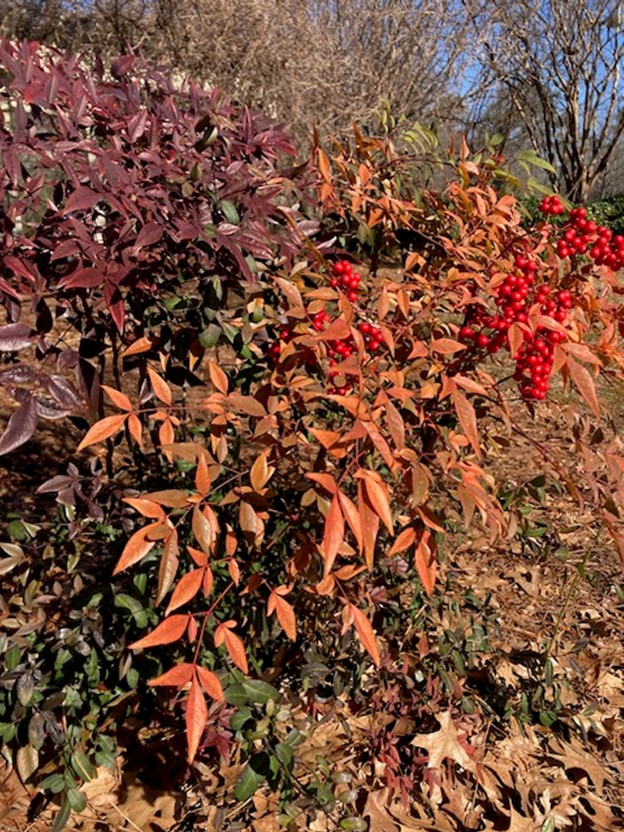
Monday: 2/24/2025
Name: Nandina or Heavenly Bamboo. Nandina domestica
Description: Nandina is an ornamental upright evergreen shrub native to China and Japan. Nandina flowers in late Spring and its bright red berries persists through the Winter. New growth on the shrub frequently has a reddish tint.
Why Remove: Shade tolerant and deer resistant, Nandina will spread aggressively into woodlands displacing native species. The berries contain a poisonous cyanide compound which has been linked to the deaths of Cedar Waxwings.
Native alternatives: The native Holly Winterberry (Ilex verticillata) is a good substitute for Nandina. Winterberry shrubs are shade tolerant, deer resistant and display a bright red berry in late Fall and early Winter. Inkberry (Ilex glabra) is another evergreen option with dark berries. While not evergreen, American Beautyberry (Callicarpa americana) is another good substitute for Nandina.
Written by Fayette MGEV: R. Guillory
Photo Credit: R. guillory
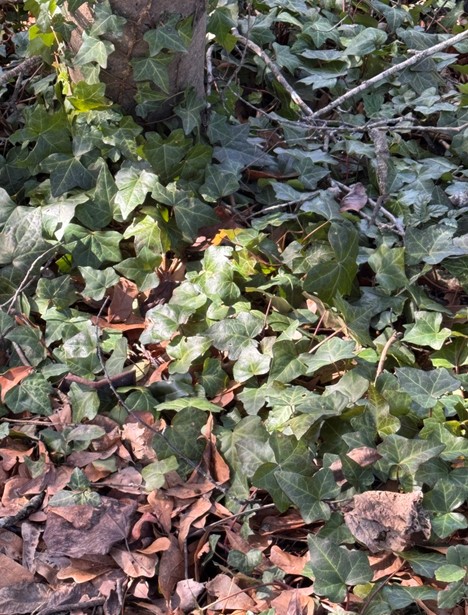
Tuesday 2/25/2025
Name: English Ivy (Hedera helix)
Description: Brought over from European Colonists in the 1700’s, English Ivy is an evergreen climbing perennial that adheres to the ground and trees.
Why remove: It has taken over as an aggressive ground cover and creeps up the trees causing decline and eventual death of the tree. In order to return our yards and forests to a habitat that supports native plants and insects, English Ivy should be removed.
Native alternatives: Climbing Hydrangea (Hydrangea barbara), Crossvine (Bignonia capreolata), Carolina Jessamine (Gelsemium sempervirens), Passion Flower (Passiflora incarnata).
Written by Fayette MGEV: C. Hemphill
Photo credit: C. Hemphill
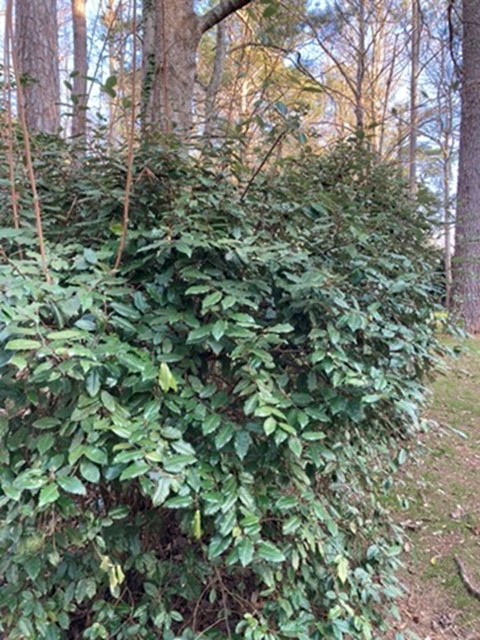
Wednesday 2/26/2025
Name: Autumn Olive (Elaeagnus umbellata thunb.)
Description: A plant brought to the United States from East Asia in the 1830’s. Leaves are alternate, oval to lanceolate, and untoothed with a dark green color. The distinguishing characteristics are the silver-white scales covering the underside of the leaves, and the thorny branches.
Why remove: Due to its prolific fruiting and fast growth, it has become troublesome for native plants to establish.
Native alternatives: American Holly (Ilex opaca).
Written by Fayette MGEV: N. Dodgen
Photo credit: R. Guillory
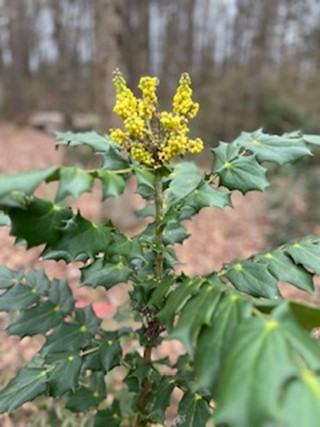
Thursday 2/27/2025
Name: Leatherleaf mahonia (Mahonia japonica bealei)
Description: This plant is native to China and is used as an ornamental landscape plant. It is evergreen, shade tolerant, deer resistant and can grow 5-10 feet. It flowers in late winter/early spring with fragrant yellow blooms which then form grape like clusters of berries.
Why remove: All of that makes it sound very attractive until you realize it will rob native plants of space, moisture, nutrients and sunlight. If left alone it will form dense thickets that are impossible to penetrate due to the spines on the leaves. Choose instead a native plant which will benefit not only your landscape but beneficial insects and wildlife
Native alternatives: Black chokeberry (Armia melanocarpa), American beautyberry (Callicarpa americana), American holly (Ilex opaca), Winterberry (Ilex verticillata), Southern wax myrtle (Morella ceritera), Highbush blueberry (Vaccinum corymbosan), Oregon grape holly (Mahonia aquifolium) – looks like the leatherleaf Mahonia
Written by Fayette MGEV: J. Lester
Photo credit: J. Lester
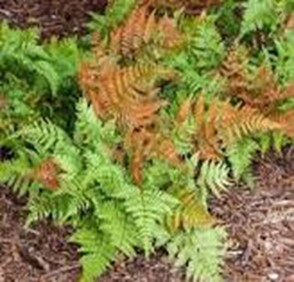
Friday 2/28/2025
Name: Autumn Fern, Japanese Shield Fern (Dryopteris erythrosora)
Description: Autumn Fern is native to Japan, China, Korea and other eastern Asian nations. This fern prefers acid rich, moist woodland habitats. It withstands full shade, tolerates drier conditions and is seldom damaged by rabbits and deer. Autumn Fern is an evergreen and is valued for its color changes as fronds mature from coppery-red to light green to a darker green. Plants spread slowly through underground rhizomes but may disperse more widely by spores produced on the frond underside.
Why remove: Because Autumn Fern has been found naturalizing in Georgia, North Carolina, Kansas, Washington DC and New York City it is now considered an invasive exotic species. In Georgia several northern county forests have been invaded by Autumn Fern potentially threatening the flora of our native forest habitats.
Native alternatives: Evergreen Wood Fern (Dryopteris intermedia), Southern Wood Fern (Dryopteris ludoviciana), Dixie Wood Fern (Dryopteris x australis), Christmas Fern (Polystichum acrostichoides), Sensitive Fern (Onoclea sensibilis), Cinnamon Fern (Osmunda cinnamomea), Royal Fern (Osmunda regalis var. spectabilis), Netted Chain Fern (Woodwardia areolata), Allegheny Spurge (Pachysandra procumbens), Alumroot (Heuchera americana), Woodland Phlox (Phlox divaricata).
Written by Fayette MGEV: R. Middleton
Photo credit: R. Middleton
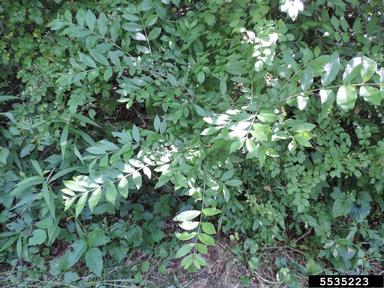
Saturday 3/1/2025
Name: Chinese Privet (Ligustrum sinense)
Description: Privet, a semi-evergreen shrub or small tree originally from Europe and Asia, grows 20 ft high. Leaves are oblong and “opposite”, 1-2.4” long and 0.2-0.6” wide with fine hairs underside the midvein. White to cream clustered petals bloom from April – June. Flowers are unpleasantly fragrant causing sinus irritation and pollen can cause allergic reactions. The fruit start green, ripen to dark purple, then black and persists into winter.
Why remove: Chinese privet is an exotic weed, highly aggressive, and troublesome. Since its introduction to the U.S. in 1852 as an ornamental hedgerow plant, it had invaded entire forests by 1950. It colonizes by root sprouts and widely dispersed seeds. Its dense thickets outcompete and smother native plants and vegetation, disrupting the ecological balance of the landscape. Ligustrum produces fruit toxic to humans causing nausea, headache, abdominal pain, vomiting, diarrhea, weakness, and low blood pressure and body temperature. Once established, control is a challenge.
Native alternatives: Swamp Cyrilla (Cyrilla racemiform), Mountain Laurel (Kalmia latifolia), Sweet Bay Magnolia (Magnolia virginiana), Dwarf Wax-myrtle (Myrica cerifera), Florida Anise, (Illicium floridanum)
Written by Fayette MGEV: K. McKernan
Photo credit: Richard Gardner, www.bugwood.org
Please contact the Fayette County Extension Office if you have questions on how to remove these and other invasive plants in your landscapes.
Kim Toal, is the Fayette County Extension Coordinator and Agent for Agriculture and Natural Resources. For more information on gardening in Fayette County, contact Fayette County Extension at 770-305-5412 or online at www.ugaextension.org/fayette.